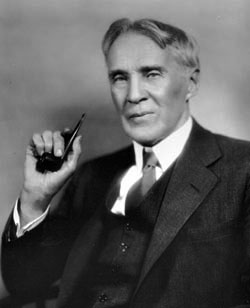September 1904: Robert Wood debunks N-rays
 |
Shortly after the discovery of X-rays in 1895, there was a flurry of research activity in the area, with many scientists expecting more similar discoveries. So when another new type of radiation was reported in 1903, it generated a lot of excitement before it was proved false in September 1904.
The first claimed discovery of the new type of radiation was made by René Prosper Blondlot, a physicist at the University of Nancy in France. Blondlot, a respected scientist and member of the French Academy of Sciences, had been experimenting with the polarization of X-rays when he found what he thought was a different type of radiation. In the spring of 1903, Blondlot published his first report on the new rays in the Proceedings of the French Academy (the Comptes Rendus). He called the new rays N-rays, with N standing for Nancy, his hometown. The N-ray discovery was something of a matter of national pride for the French, since X-rays had been discovered by Wilhelm Conrad Roentgen, a German.
Blondlot used various kinds of apparatus to observe the rays, which were purportedly just barely detectable. In his first experiments, he detected the rays through slight variations in the brightness of a small electric spark when the rays fell on it. Later, he used screens with a phosphorescent coating, which would supposedly glow slightly brighter when hit by N-rays. He thought the new rays were also a form of light, and found that they could be polarized, reflected, and refracted.
Within months of Blondlot’s first announcement, many scientists–mostly French scientists, but a few others as well–would claim to have seen the rays. Hundreds of papers were soon published on the topic, including 26 papers by Blondlot himself.
Soon various properties of the N-rays were “discovered.” For instance, the rays were found to go through wood and metals, but were blocked by water. They were emitted by the sun, gas burners, and metals, but not wood, and could be stored in a brick.
Other scientists proposed applications of the mysterious radiation. For instance, Augustin Charpentier, a professor of medical physics at the University of Nancy, reported that the rays were emitted by rabbits and frogs, and the human brain, muscles, and nerves. He predicted that N-rays, like X-rays, could be useful for medical imaging, to see the outline of internal organs. Another N-ray researcher, Jean Becquerel, son of Henri Becquerel who discovered radioactivity, claimed that N-rays could be transmitted over a wire.
These scientists seem to have genuinely believed in their claimed observations, but many other scientists found they could not replicate the results. In fact, they could not see any evidence of N-rays at all. Blondlot and others N-ray believers argued that those who couldn’t see the rays simply didn’t have sufficiently sensitive eyes to detect the effects of N-rays, which were supposedly just at the limits of visibility.
The physics community was divided on the issue. One physicist who had been unable to detect the N-rays in his own lab was Robert Wood, of Johns Hopkins University. Wood, who did research on optics and electromagnetism, was known for his diverse interests and his enjoyment of pranks.
In the summer of 1904, Wood was sent to France to observe Blondlot’s experiments, in hopes of clearing up the matter.
Blondlot and his assistants set up several of their demonstrations for Wood. In the most well known demonstration, Blondlot showed how N-rays could be spread out into a spectrum by an aluminum prism. Blondlot claimed to detect this spectrum by noting a slight increase in brightness at some points along a phosphorescent strip. Wood could see no evidence of the N-ray spectrum.
The experiments had to be done in a darkened room, which gave Wood the opportunity to play a trick: unseen by Blondlot and his assistant, Wood removed the crucial prism from the apparatus. He then asked Blondlot to repeat the observations of the N-ray spectrum.
Not knowing the prism had been removed, Blondlot continued to insist he saw the very same pattern he had claimed to see when the prism was in place.
After several similar demonstrations, Wood was completely convinced that Blondlot and others were imagining the phenomenon.
On September 22, 1904, Wood sent off a letter to Nature describing his visit to Blondlot’s lab, and his conclusion that N-rays were non-existent. “After spending three hours or more in witnessing various experiments, I am not only unable to report a single observation which appeared to indicate the existence of the rays, but left with a very firm conviction that the few experimenters who have obtained positive results have been in some way deluded,” he wrote in his report to Nature. Although Wood didn’t mention Blondlot by name in the article, anyone reading it would have known whose experiments it referred to.
Wood’s report was published in the September 29, 1904 issue of Nature. Within months, almost no one believed in N-rays anymore. The issue was considered resolved. Blondlot, however, refused to admit he had been in error, and kept working on N-rays for years after others had given up on them.
The story of N-rays, which fooled many respectable scientists, has been used ever since as a cautionary tale of how easy it is to deceive oneself into seeing something that is not really there.
©1995 - 2024, AMERICAN PHYSICAL SOCIETY
APS encourages the redistribution of the materials included in this newspaper provided that attribution to the source is noted and the materials are not truncated or changed.
Contributing Editor: Jennifer Ouellette
Staff Writer: Ernie Tretkoff
August/September 2007 (Volume 16, Number 8)
Articles in this Issue

